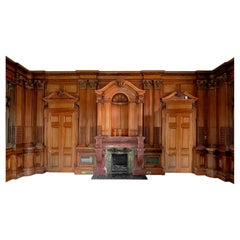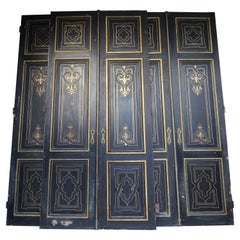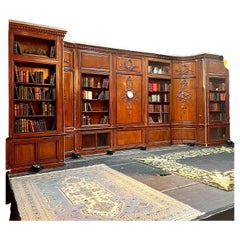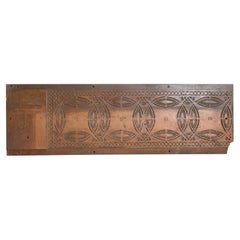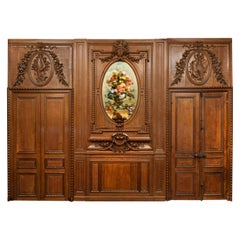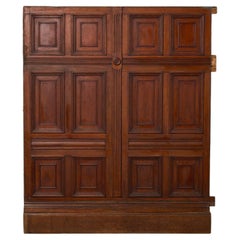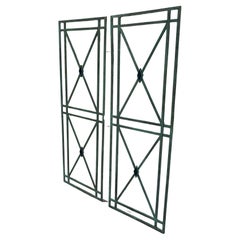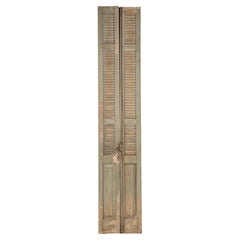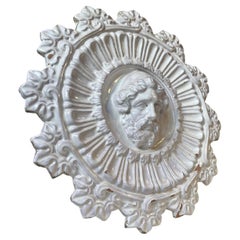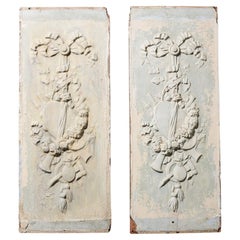Late 19th Century Panelling
to
5
14
14
28
Height
to
Width
to
5
3
2
1
1
1
40
88
99
87
35
37
11
8
1
4
4
3
17
3
2
3
1
21
9
5
3
3
16
7
7
6
5
28
28
28
3
Period: Late 19th Century
George Trollope & Sons fireplace & room, Paris Exhibition 1878 Gold Medal Winner
Located in London, GB
George Trollope and Sons. Exhibited at the Paris Universal Exhibition in 1878 winning a Gold Medal for Excellence.
The set forms the four sides of a complete panelled room that was exhibited as a boudoir room or petit salon at the Paris Exhibition 1878 .
The main feature and centrepiece of this boudoir room is the Rosso Antico marble fireplace surmounted by an open display niche carved in cedar wood.
Each side of the room is composed of various panels and are as follows:
One side with a grand Rosso Antico marble fireplace flanked by two doorways.
One side with French doors originally opening onto a balcony, flanked by two large bookshelves.
One side with a window flanked by two mirrors. The opposite side with three large mirrors.
The complete room measures:
21 ft / 6.4 m wide, 17 ft / 5.18 m deep, and 12 ft / 3.65 m high.
It could also be used in a number of different combinations to suit various room layouts. The mirrors could be replaced with windows or further bookcases.
Each side is decorated with various sizes of finely carved panels and holds ornate Corinthian style columns surmounted with cherubim's on the capitals. Three cherubs are formed at the top of each corner with three columns, at the column bases there are circular carved pedestals to display statues.
Published & illustrated in the ‘Illustrated Catalogue of the Paris International Exhibition’.
The main part of this room, the Rosso Antico marble fireplace is surmounted by a large open display niche carved in cedar wood are illustrated with a line drawing in the Paris Universal Exhibition catalogue on page 209. The whereabouts of the seminaked caryatids and the marble bust of Alexander Pope are unknown. The bust of Alexander Pope was copied from the original one in Westminster Abbey, London.
The Corinthian columns now flanking the niche above the fireplace are also in cedar wood having the identical carved fluting to the rest of the room and were made to replace the caryatid figures. Those Corinthian columns are period to the room and can only have been made shortly after it arrived back to London and before it was reassembled and fitted into the house built by George Trollope and Sons in the 1880's, and where we removed it all from.
George Trollope made clever use of Alexander Pope's early 18th-century poetical successes in Great Britain and France by using ‘The Rape of Lock’, a mock-heroic narrative poem Pope wrote in 1712 about Petre who cut off a lock of Arabella’s hair without her permission, as the theme of the boudoir room or petit salon at the 1878 Paris Exhibition.
In the original exhibition display of the room set, tapestries depicting the Rape of Lock were hung where the mirrors are now positioned.
Alexander Pope's The Rape of the Lock is a humorous indictment of the vanities and idleness of 18th-century high society. Basing his poem on an actual incident among two families of his acquaintance, Pope intended his verses to quench hot tempers and to encourage his friends to laugh at their own foolishness.
The poem is an outstanding example in the English language of the genre of mock-epic. The 'epic' was considered one of the most serious of literary forms; it had been applied, in the classical period, to the trivialities of love and war. Pope’s mock-epic is not to mock the form itself, but to mock his society in its very failure to rise to epic standards, exposing its pettiness by casting it against the grandeur of the traditional epic subjects and the bravery and fortitude of epic heroes: Pope’s mock-heroic treatment in The Rape of the Lock underlines the ridiculousness of a society in which values have lost all proportion, and the trivial is handled with the gravity and solemnity that ought to be accorded to truly important issues. The 18th-century society in this poem fails to distinguish between things that are important and things that are not. The poem mocks the men it portrays by representing them as unworthy of a heroic culture. Therefore the mock-epic follows the epic in that its main concerns are serious and moral. The point that the theme must now be satirical rather than earnest is symptomatic of how far the culture has fallen.
Retaining the original exhibition label
The back of the panelling still retains two original labels printed with the 'Union Jack' and printed adjacent to it, 'The Secretary Royal British Commission for the Universal Exhibition 1878 Champ de Mars Paris'.
Adjacent to that and below, printed and written in ink vertically:
Exhibitor: (and signed in ink) George Trollope & Sons.
Address: (written in ink) Halkin Street West. London.
Allotment in Block: (written in ink) a2. In the printed floor plan 'a2 square' is in the very first line to the right of the floor plan and handwritten in ink with a 'diamond shape' also written with '101' within it. This pin points where George Trollope's stand was located.
With thousands of items being displayed at the Exhibition, this label would have been the floor plan for the craftsmen, so they knew the correct place to install the boudoir room or petit salon.
The firm continued expanding house building and interior decoration side of the business and by 1849 was also trading as an estate agency, letting and controlling property for the Grosvenor Estates. A separate branch of cabinet-makers, bearing the family name, was opened at West Halkin Street, London. becoming known as 'The Museum of Decorative Arts' (looked after by George Robinson). Here Trollope and Sons also sold high-class antique furniture made by other makers. In 1851, the firm became formally known as George Trollope and Sons. West Halkin Street, London. The address was recorded in the listing for the firm in The Furniture Gazette Directory, 1876 & 1877.
Period Press Coverage & Art Critic Review.
everal newspapers also thoroughly describe George Trollope and Son's stand including the different tapestries that were hung where the mirrors are now, illustrating the poem 'The Rape of Lock', by Alexander Pope.
Marius Vachon, a French Art Critic and journalist, who wrote for the journal ‘La France’ published an extensive review of the Trollope and Sons stand in a book called Les Merveilles de l'Exposition de 1878 (The Wonders of the 1878 Exhibition).
Note: In the World Fairs translation it states door frame, Marius Vachon had originally written ‘chambranle’ in French, 'chambranle' loosely translates to a frame around something, and should read in its correct context: ‘fireplace in rosso antico’.
We have taken the extract below written by Marius Vachon in its translated form from: Les Merveilles de l'Exposition de 1878, (The Wonders of the 1878 Exhibition). This puts into perspective the importance of this fine quality room interior when he viewed it at the exhibition in 1878:
Marius Vachon: English furniture is very curious to observe; irreproachable from the point of view of execution, the furniture of our neighbours always reaches the last degree of respectability and comfort. One thing to be noticed is that for large pieces of furniture, the English upholsterer is transformed into a sort of architect; everything he makes takes on a monumental aspect.
The first object that catches the eye when one enters the furniture class is the beautiful boudoir-salon exhibited by Mr. Trollope. The boudoir (or petit salon), of carved cedar wood, is an attempt to reproduce the style which prevailed in England during the first decade of Queen Anne's reign, and all the details have been studied, but not copied, from examples of decorative work of the time. The fireplace is in "rosso antico" movement, and the ceiling is in portable plaster. The panels painted on canvas represent scenes from the heroic-comic poem "The Abduction of the Hairpin," (The Rape of Lock) written by Alexander Pope in 1712, the eighth year of Queen Anne's reign, in which the customs and mores of the time are satirized in a pleasing manner.
The apotheosis of the Loop and its sidereal transformations will form the decoration of the ceiling. In these illustrations of Pope's charming poem, the costumes and accessories have been taken from models of the time; and the bust of the poet, copied from his tomb in Westminster Abbey, occupies the niche in the centre of the mantelpiece.
M. Marius Vachon, the period writer of the above continues with:
Now we shall mention at random the magnificent dining table of Messrs. Johnston and Co., their oak mantelpiece, their boudoir table; Mr. Watt's drawing-room mantelpiece stepped in the old style and imitating the Japanese; Mr. James Shoolbred's great
The Decorative Arts Society on Trollope and Sons
The boudoir or petit salon is mentioned again in the Decorative Arts Society:
Trollope did not exhibit such highly rated objects at the 1878 Paris Exhibition as at previous exhibitions; items included a large mirror frame carved in limewood in Renaissance style and a satinwood cabinet in Adam revival style, with a similar armchair (illus. Meyer (2006), p. 242) and probably two rooms; one was a boudoir in cedar wood in Queen Anne style and the other was a boudoir decorated by the firm in the theme of Pope’s The Rape of Lock.
In the above extract, it is quite clear that the two rooms mentioned are in fact the very same room, because the fireplace and niche are illustrated in The Paris Universal Exhibition catalogue on page 209 and Marius Vachon describes the rest of the room set in the above…
Trollope and Sons exhibition pieces listed and described by Meyer in an article he wrote for: The Decorative Arts Society 1850 to present, Journal 25 in 2001., where he points out the importance of George Trollope and Sons and mentions a table by Trollope exhibited at the 1867 exhibition that sold for £40,000 in 1996. He also mentions a cabinet exhibited by Trollope at the International Exhibition of 1862 that sold at Sotheby's in 1997 for £150,000.
Interest was not as strong in the 1990's as it is today for rare exhibition pieces, high quality items were abundant back then, it was a golden era when the most beautiful works of art just kept coming onto the market. But there are exceptions as in this instance, when a unique, gold medal-winning exhibition work of art comes onto the market for the very first time.
Meyer continued researching and writing about the great exhibitions and released his book in 2006, 'The Great Exhibitions, London, New York, Paris and Philadelphia 1851- 1900, where he mentions only in passing, The Boudoir Room or Petite Salon exhibited by Trollope, he even states that an image was not reproduced and that Trollope's exhibits in 1878 were not up to the quality and class of the items Trollope exhibited in London in 1862 and Paris in 1868. This is probably because Meyer didn't know of the line drawing illustrating the Roso Antico Fireplace, Niche and Panelling reproduced in The Illustrated Catalogue of the Paris International Exhibition 1878 shown in the above which Geering recently uncovered.
John Meyer continues in the DAS journal:
Undoubtedly they (Trollope) are a firm worthy of further research as they were right at the forefront of the furniture business in London from 1860 to 1880.
Our research shows that the Petite Boudoir was awarded the gold medal for excellence in 1878 (see Journal La Liberté 23-10-1878 with the list of all medals attributed), something George Trollope and Sons did not achieve at the London 1862 and the Paris 1867 exhibitions. Jonathan Meyer joined Bonham's in 1977. He was Director at Sotheby's in charge of 19th Century Furniture from 1994 to June 2007. He was also chairman of the Fine Arts Faculty for The Royal Institute of Chartered Surveyors.
In the original description from the article in Les Merveilles de l’exposition de 1878, M. Marius Vachon states:
The first object that catches the eye when one enters the (English) furniture class is the beautiful boudoir-salon exhibited by Mr. Trollope.
Suggesting, it was in his opinion the very best on display in the English section, and being awarded the gold medal for excellence can only add weight to this.
Adjacent to the original label that was printed by The Secretary - Royal British Commission for the Universal Exhibition 1878 in stencil ‘TO BE KEPT’, i.e. ‘to be returned’. This confirms why it came back to London. We removed the Boudoir Room or Petite Salon from a Trollope house, part of a grand high-class housing estate in London which around the time of the exhibition Trollope and Sons were in the process of building, and where the room set was installed directly after it returned from the exhibition in 1878 until now.
Worthy of note is the machines that did the carving for the Boudoir Room or Petite Salon and also did all of the decorative carving (most of which was linenfold carving) for the Houses of Parliament, London.
This machine, the engraving and description of which we copy from Engineering, was specially designed by its inventor, Mr. Jordan, for assisting in the production of the vast amount of carved decorations required for the walls and ceilings of the Houses of Parliament, London, and it was so employed during the entire progress of the work. The late Sir Charles Barry was so well satisfied with it, that he frequently declared it would have been impossible to have accomplished the work without it. The Department of Woods and Forests employed five of the machines at the Government Works, Thames Bank, for several years; and the machines have now passed into the hands of Messrs. George Trollope and Son, and are still used in the same building.
They also exhibited the new technique of xylatechnography and sgraffito, methods of impressing coloured design into soft wood and engraving veneer to reveal the base wood.
The newspaper, La Liberte October, 23rd 1878 listing the medal winners of the Paris 1878 exhibition. Third column, ''GROUPE III MOBILIER ET ACCESSOIRES'', (GROUP III FURNITURE AND ACCESSORIES). Medailles d'or. (Gold Medals) where G Trollope et fils (G Trollope and Sons...
Category
Antique Late 19th Century Panelling
Materials
Marble
Late 19th Century French Art Nouveau Double Doors, Set of 3
Located in Dusseldorf, DE
Rare set consisting of 3 identical French Art Nouveau double doors from around 1900. Unrestored condition.
Solidly made of pine wood in frame construction with 3 panels each and p...
Category
French Art Nouveau Antique Late 19th Century Panelling
Materials
Pine
Louis XVI style woodwork 16m linear
Located in TOURCOING, FR
Monumental Louis XVI Style Boiserie – 16 Linear Meters
A rare and exceptional Louis XVI style wood paneling ensemble, spanning an impressive 16 meters in length and 3.55 meters in h...
Category
French Louis XVI Antique Late 19th Century Panelling
Materials
Wood
$28,720 / item
Copper Over Cast Iron Column Fragment from the Chicago Stock Exchange
Located in Round Top, TX
Copper over cast iron column fragment from the elevator pilasters at the Chicago Stock Exchange. Louis Sullivan, architect.
Category
North American Antique Late 19th Century Panelling
Materials
Copper, Iron
Antique 19th Century French Chateau Oak Paneled Salon Room "Boiserie" circa 1865
Located in New Orleans, LA
A complete boiseries from the French country estate: "Chateau de Quatres Barbes." The antique 19th century French Louis XVI style grand oak paneled salon room...
Category
French Louis XVI Antique Late 19th Century Panelling
Materials
Marble
11m Run of Full Height Reclaimed Oak Wall Panelling
Located in Wormelow, Herefordshire
A 11m run of full height reclaimed oak wall panelling with a handsome dark wood patina, sourced from a period building in London.
Dating from the early 20th century, this set of sol...
Category
English Edwardian Antique Late 19th Century Panelling
Materials
Oak
Pair of Antique French Shutter in Old Crumbly Paint From a Chateau in Brittany
Located in Chicago, IL
Antique pair of French shutters in very old paint removed a long time ago from a chateau located in Brittany.
**Width provided is for the wider shutte...
Category
French Country Antique Late 19th Century Panelling
Materials
Wood, Paint
Ecclesiastical Style Wall Panel or Door
Located in Wormelow, Herefordshire
Sourced from an English church, this ecclesiastical style wall panel or door has an unusual design, making a stunning feature in any setting. It is crafted in pine with vertical paneling below a large horizontal panel...
Category
English Victorian Antique Late 19th Century Panelling
Materials
Wood, Pine
Antique Colonial Ceiling in Embossed Sheet Metal, White, 19th Century, Italy
Located in Cuneo, Italy (CN)
Antique set of 16 square meters of boiserie or ceiling panels, in white lacquered sheet metal, hand-embossed with typical tiles of the time, each panel measures 60 cm x 180 cm and ha...
Category
Italian Antique Late 19th Century Panelling
Materials
Sheet Metal
$10,530 Sale Price
20% Off
2 Antique Eastlake Victorian Architectural Salvage Molding Panels Column Pillar
Located in Dayton, OH
Pair of victorian eastlake architectural moldings. Features a sawtooth block leading to corbel and long fluted panel.
Category
Eastlake Antique Late 19th Century Panelling
Materials
Hardwood
$720 Sale Price / set
20% Off
Set of Two Large French 19th Century Curved Hand Carved Walnut Panels
Located in Santa Monica, CA
Set of two large French 19th century curved hand carved walnut panels.
Category
French Antique Late 19th Century Panelling
Materials
Walnut
$1,438 Sale Price / set
40% Off
Large Antique Oak Wall Panel
Located in Wormelow, Herefordshire
A single large antique oak wall panel salvaged from a British church. It dates from the early 1900s during the Victorian era and features solid oak construction with a rich warm wood...
Category
English Victorian Antique Late 19th Century Panelling
Materials
Wood, Oak
Antique Tin Ceiling Remnant
Located in New York, NY
We have taken these beautiful abandoned decorative tin ceilings and turned them into art pieces, framed with wood. By the late 1870s, tin began to appear o...
Category
American Industrial Antique Late 19th Century Panelling
Materials
Tin
19th Century Diminutive Inlaid Wood Framed Panels
Located in Lambertville, NJ
A pair of diminutive mahogany and satinwood inlaid framed panels. The wood panels with inlays of kings wood, tulip wood and satin wood with floral and in...
Category
European Victorian Antique Late 19th Century Panelling
Materials
Mahogany
$713 Sale Price / set
24% Off
17m Run of Late 19th Century Carved Oak Panelling
Located in Wormelow, Herefordshire
A good quality 17m run of late 19th century carved oak panelling with a rich oak colour and ornate varied carving, reclaimed from a property in Staffordshire.
Standing at ¾ height, this reclaimed wall panelling...
Category
English Victorian Antique Late 19th Century Panelling
Materials
Wood, Oak
French Set of 4 Majolica Flowers Tiles, circa 1890
Located in Austin, TX
French set of 4 Majolica flowers tile, circa 1890.
6' by 6" , The four tiles 12' by 12".
Category
French Aesthetic Movement Antique Late 19th Century Panelling
Materials
Faience
Victorian Reclaimed Mahogany Counter or Bar Panelling
Located in Wormelow, Herefordshire
Three sections of reclaimed Victorian mahogany bar counter panelling.
Additional Dimensions:
2 panels- 96 x 108 x 4 cm
1 panel- 94 x 76 x 4 cm
Category
English Antique Late 19th Century Panelling
Materials
Mahogany, Wood
Folk Art Americana Victorian Carved Mirrored Carousel Panels
Located in Queens, NY
5 American Victorian stripped and decorated carved carousel panels with oval etched mirror (priced each).
Category
American Folk Art Antique Late 19th Century Panelling
Materials
Wood
Scagliola panel, Flowers And Birds Decor, Late 19th Early 20th Century
Located in MARSEILLE, FR
Scagliola panel decorated with multicoloured flowers and leaves and a parrot in the centre, on a black background
Scagliola technique, already known in antiquity, consists mainly of...
Category
Italian Renaissance Antique Late 19th Century Panelling
Materials
Scagliola
Copper over Cast Iron Column Fragment from the Chicago Stock Exchange
Located in Round Top, TX
Copper over cast iron column fragment from the elevator pilasters at the Chicago Stock Exchange. Louis Sullivan, architect.
Category
American Antique Late 19th Century Panelling
Materials
Copper, Iron
Two Chinese panels, late 19th century, China, circa 1880
Located in Paris, FR
Two large panels of a Chinese wedding bed, richly carved with figures, festive scenes, gifts and symbols of prosperity.
Carved wood, red lacquer, gold leaf and black lacquer. China, late 19th century.
The two panels are not quite the same size.
Panel N° 1: 41.7 x 76.77 in.
Panel N° 2: 48 X 80 in
Category
Chinese Antique Late 19th Century Panelling
Materials
Gold Leaf
Pair of Antique Decorative Oak Church Panels
Located in Wormelow, Herefordshire
This pair of antique carved oak church panels would’ve once formed part of a rood screen, separating the nave from the chancel. Dating from the late 19th c...
Category
Victorian Antique Late 19th Century Panelling
Materials
Oak
Copper over Cast Iron Column Face Fragment from the Chicago Stock Exchange
Located in Round Top, TX
Copper over cast iron column fragment from the elevator surround pilasters in Chicago Stock Exchange. Louis Sullivan, architect.
Category
American Antique Late 19th Century Panelling
Materials
Copper, Iron
Pair of Antique Silver Giltwood Regency Style Pilasters
Located in Hanover, MA
Pair of tall slender tapered pilasters, silver gilt, 8ft 8 inches tall, finely carved in the typical shallow relief manner of the Régence period.
Gorgeous patina on silver gilding.....
Category
French Regency Antique Late 19th Century Panelling
Materials
Silver Leaf
Antique Tin Ceiling Remnant
Located in New York, NY
We have taken these beautiful abandoned decorative tin ceilings and turned them into art pieces, framed with wood. By the late 1870s, tin began to appear o...
Category
American Industrial Antique Late 19th Century Panelling
Materials
Tin
Antique Tin Ceiling Remnant
Located in New York, NY
We have taken these beautiful abandoned decorative tin ceilings and turned them into art pieces, framed with wood. By the late 1870s, tin began to appear o...
Category
American Industrial Antique Late 19th Century Panelling
Materials
Tin
Three Pieces of Salvaged Wooden Panelling
Located in Wormelow, Herefordshire
Three reclaimed wooden partitions / panelling. Three sections of panelling that would be well suited for repurposing as sliding doors or room partitio...
Category
Antique Late 19th Century Panelling
Materials
Wood, Pine
Antique Pair of Two-Panel Lacquered Doors, White and Gray, 19th Century, Italy
Located in Cuneo, Italy (CN)
Ancient pair of two-panel lacquered doors, with leaf decorations in white and gray, manufactured in the 19th century in Italy.
No. 2 identical doors, decorated the same in front and...
Category
Italian Antique Late 19th Century Panelling
Materials
Wood
$4,403 Sale Price / set
20% Off
Related Items
French Directoire Style Bronze Wall Panels
Located in Sherborne, GB
French Directoire style bronze wall mounted panels, the classic X-frame panels with central diamond made from molten enamel.
So stylish, these panels can be wall mounted to give ...
Category
French Directoire Late 19th Century Panelling
Materials
Bronze
Pair of Antique French Shutter in Old Crumbly Paint From a Chateau in Brittany
Located in Chicago, IL
Antique pair of French shutters in very old paint removed a long time ago from a chateau located in Brittany.
**Width provided is for the wider shutte...
Category
French Country Antique Late 19th Century Panelling
Materials
Wood, Paint
$450 / set
H 119 in W 11.38 in D 1.75 in
Outstanding Set of 3 16th Century Spanish Ceiling Panels, Beams
Located in Round Top, TX
An outstanding and exceptional set of 3 16th century ceiling panels - beams from Barcelona. Hand hewn solid wood panels beautifully painted. Fabulous architectural elements to incorp...
Category
Spanish Antique Late 19th Century Panelling
Materials
Wood
$8,950 / set
H 10 in W 92.5 in D 1.5 in
Pair of English Gothic Revival Oak Railings
Located in Queens, NY
Pair of English Gothic Revival style (19th Century) oak carved railing panels with open design and finial (PRICED AS Pair).
Category
British Gothic Revival Antique Late 19th Century Panelling
Materials
Oak
Folding Screen Room Divider in Solid Mahogany
Located in Mexico City, CDMX
We offer this folding screen made in solid frames of mahogany wood with brass details, circa 1950.
Category
Mexican Mid-Century Modern Vintage Late 19th Century Panelling
Materials
Mahogany
19th Century Wooden Double Front Door in Art Nouveau Style, Spain
Located in Vulpellac, Girona
19th century double front door with patina in Art Nouveau style from Catalonien, Spain.
Carved wood typical from this period.
The door is framed and working but needs some restorat...
Category
Spanish Art Nouveau Antique Late 19th Century Panelling
Materials
Wood
$5,744 Sale Price
20% Off
H 98.43 in W 61.42 in D 3.94 in
Pair of 18th Century Hand Carved Panels
Located in High Point, NC
Pair of 18th century hand carved panels. They have hand carved banding surrounding raised panels with hand carved designs, including florals, vines, and carved transom like patterns ...
Category
English Georgian Antique Late 19th Century Panelling
Materials
Oak
Exceptional 18th Century Oak Boiserie Panel from Chateau Saint-Maclou, Normandy
Located in Dallas, TX
This fabulous hand-carved boiseries or wooden panel was recently purchased from the Chateau St. Maclou in Normandy, France. Rooms of boiseries had design motifs that were kept the same throughout the entire area that was paneled. For instance, on this panel, there are mainly acanthus leaf motifs used in various areas. A medieval lion...
Category
French Antique Late 19th Century Panelling
Materials
Oak
$9,800
H 50.75 in W 45.38 in D 4.38 in
Folding Screen Room Divider in Solid Wood
Located in Mexico City, CDMX
We offer this folding screen made in solid wood with brass details, circa 1950.
Category
Mexican Mid-Century Modern Vintage Late 19th Century Panelling
Materials
Cedar
Antique 6 Foot Structural Cast Iron Fluted Column
Located in New York, NY
Thick cast iron column with a fluted body and decorative capital. The bottom is uneven and 6 inches will need to be cut off to make it even thus shorting its height. Please note, thi...
Category
American Industrial Late 19th Century Panelling
Materials
Iron
Pair of Large Gio Ponti Cherrywood Boiserie Panels from Hotel Royal, Naples 1955
Located in Rome, IT
A pair of unique Gio Ponti wood panels from the furniture of the Hotel Royal in Naples, 1955.
Manufactured by Giordano Chiesa by Dassi.
cherrywood
thick edge with owl's beak
these pi...
Category
Italian Mid-Century Modern Vintage Late 19th Century Panelling
Materials
Cherry
$5,973 / set
H 31.5 in W 81.5 in D 1.66 in
Metal and Rattan Screen or Room Divider from England
Located in Los Angeles, CA
This screen from England skillfully combines a metal frame designed to mimic bamboo with intricately woven rattan panels. The unique blend of materials and design creates an airy and...
Category
English Edwardian Antique Late 19th Century Panelling
Materials
Metal
Previously Available Items
Antique Italian Medallion Ornament in Glazed Terracotta, 19th Century
Located in Esbjerg, DK
Ornamental wall medalion in burnt terracotta. The entire front is covered in its original white glaze. It was made on order in Italy circa 1850-1880. Su...
Category
Italian Victorian Antique Late 19th Century Panelling
Materials
Terracotta
Two Decorative Antique Wall Panels
Located in Wormelow, Herefordshire
Two decorative antique wall panels. In Georgian style, these panels display ornate decorative carvings of a musical instrument surrounded by elegant folia...
Category
English Georgian Antique Late 19th Century Panelling
Materials
Wood, Pine, Paint
19th Century Antique Chinese Carved Wooden Window Panel/Wall Arts
Located in Pomona, CA
This Chinese Qing Dynasty period large carved Cypress wood interior window panel from the late 19th century, with fretwork design and Chinese Opera figures at center, Created in Chin...
Category
Chinese Chinese Export Antique Late 19th Century Panelling
Materials
Cypress
Large Reclaimed Victorian Mahogany Bar Front
Located in Wormelow, Herefordshire
A large reclaimed Victorian mahogany bar front. Dating to circa 1880, the handsome fluted panelled front is complimented by decorative roundels and an original French polish finish. ...
Category
English Victorian Antique Late 19th Century Panelling
Materials
Wood, Mahogany
19th Century Antique Chinese Carved Wooden Window Panel/Wall Arts
Located in Pomona, CA
This Chinese Qing Dynasty period large carved elm wood interior window panel from the late 19th century, with fretwork design, Created in China during the Qing Dynasty in the later y...
Category
Chinese Chinese Export Antique Late 19th Century Panelling
Materials
Wood
Two Dado Height Reclaimed Oak Panels
Located in Wormelow, Herefordshire
With their aged, warm oak finish, this pair of reclaimed oak panels are steeped in history, making a handsome feature in a property with traditional styling. They date from the late ...
Category
English Victorian Antique Late 19th Century Panelling
Materials
Wood, Oak
19th Century Chinese 3d Carving Wood Panel Hanging Architectural Element
Located in Pomona, CA
This antique Chinese wood carving panel has very deep 3D carving works of Chinese folks art - Chinese Opera with gilt. Very detailed carving...
Category
Chinese Chinese Export Antique Late 19th Century Panelling
Materials
Wood
H 5.5 in W 34.5 in D 1.25 in
12.7 Meters of Antique Raised and Fielded Pine Dado Panelling
Located in Wormelow, Herefordshire
Reclaimed from a large private residence in Sunningdale, the property of a Lord and Lady.
Additional Dimensions:
Widths; 284, 376, 358 and 250 cm
Thickness 7 cm
Category
English Edwardian Antique Late 19th Century Panelling
Materials
Pine
19th Century Chinese 3d Carving Wood Panel Hanging Architectural Element
Located in Pomona, CA
This antique Chinese wood carving panel has very deep 3D carving works of Chinese folks art - Chinese Opera with gilt. Very detailed carving...
Category
Chinese Chinese Export Antique Late 19th Century Panelling
Materials
Wood
Late 19th Century Antique Chinese Hand Carved 6 Panels Wooden Screen/Room Divide
Located in Pomona, CA
A set of six Chinese Qing Dynasty period large carved wood interior door panels from the late 19th century, with fretwork design, Created in China during the Qing Dynasty in the late...
Category
Chinese Chinese Export Antique Late 19th Century Panelling
Materials
Wood
H 111 in W 128 in D 2.5 in
Georgian Style Glass Panel with Astral Glazing
Located in Wormelow, Herefordshire
A classy and stylish mahogany and glass panel dating from the late 1880s. Though originating from the Victorian era, this handsome panel is a supremely stylish addition to a 21st century home with its impressive geometric design known as astral glazing...
Category
English Georgian Antique Late 19th Century Panelling
Materials
Glass, Mahogany
Two Ecclesiastical Style Antique Carved Oak Panels
Located in Wormelow, Herefordshire
This pair of beautifully antique carved oak panels would’ve once formed part of a rood screen in an English church, separating the nave from t...
Category
English Victorian Antique Late 19th Century Panelling
Materials
Oak
Recently Viewed
View AllMore Ways To Browse
Reclaimed Paneling
French Provincial Breakfront
French Waiter
Galle Cabinet
Glazed Mahogany Display Cabinet
Gold Accent Cabinet
Gustavian Cabinet Glass
Hand Carved Wood Hooks
Hanging Hand Carved Cabinet
Hollywood Glam Furniture
Hungarian Baroque Furniture
Hutch Glass Doors
Inlaid Chinese Cabinet
Japanese Cabinet On Gilt Stand
Jean Francois Leleu
Kelly Green Furniture
Lane Furniture Cedar Chest
Linen Fold Panel
